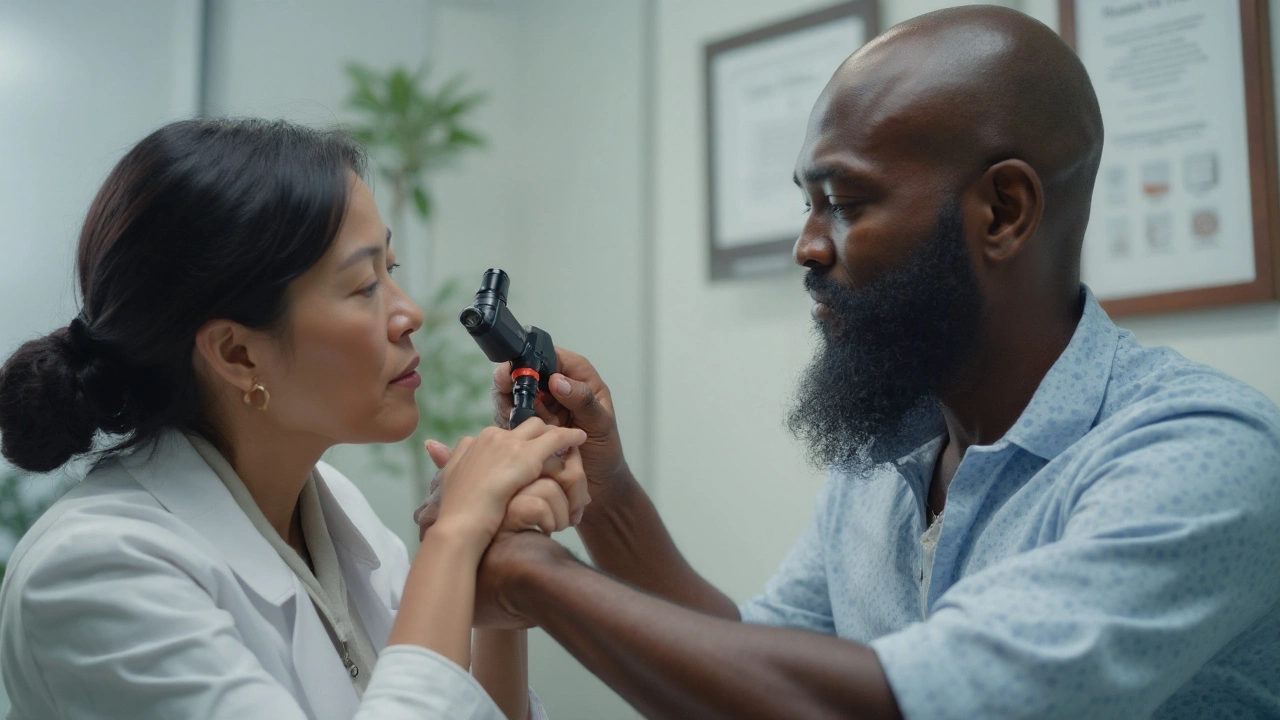Blotchy, net-like skin patches can be harmless after a chill, or they can hint at blood flow issues, autoimmune disease, infection, or a fungal rash. The tricky part is knowing which is which. Here’s a clear way to sort it out-and exactly when it’s worth booking a dermatologist.
TL;DR
- Cold-triggered mottling that warms up and fades is usually benign. Fixed, painful, or spreading patterns deserve a check.
- See a dermatologist if the discoloration doesn’t improve in 6-8 weeks, recurs without a clear trigger, or comes with pain, sores, numbness, or systemic symptoms.
- Urgent care now: fever with a new purplish rash, rapidly worsening pain, ulcers, or sudden onset after a new medication or in pregnancy.
- Expect basic labs, a skin exam, maybe a Wood’s lamp or KOH test (for fungus), and-in select cases-vascular studies or a skin biopsy.
- Sun protection, gentle skincare, and avoiding cold triggers prevent many flare-ups; treatment depends on the cause.
What “mottled” skin actually means
People describe mottled skin as marbled, blotchy, or net-like. Doctors often use terms like livedo (a lacey, purple network), cutis marmorata (cold-induced mottling), or post-inflammatory hyperpigmentation (brown or slate patches after irritation). The appearance varies by skin tone. On darker skin, the pattern may look gray, dark brown, or aubergine rather than bright red or purple.
Common patterns you might see:
- Cold-induced mottling: a reticulated (net-like) pattern that fades once you warm up. Often on legs, arms, or hands.
- Livedo reticularis: a persistent network pattern; sometimes benign, sometimes linked to circulation or autoimmune conditions.
- Fungal color shift (tinea versicolor): patchy lighter or darker areas on the chest/back that don’t tan evenly; fine scale when you scratch.
- Post-inflammatory changes: brown, slate, or gray patches left after acne, eczema, bug bites, or rashes.
- Vascular inflammation (vasculitis) or clots: painful purplish spots, net-like patches that don’t blanch, sometimes with sores.
Why does the skin look mottled in the first place? It’s usually about blood flow, pigment, or both. Cold makes surface vessels constrict and dilate unevenly. Inflammation or injury can push pigment up or down. Infections, medications, and autoimmune conditions can inflame or block small vessels, making patchy color changes.
What’s typical vs. concerning? Color that changes with temperature and isn’t painful is usually okay. Fixed patterns, pain, numbness, ulcers, or systemic symptoms (fever, fatigue, shortness of breath) move it into “get it checked” territory. The American Academy of Dermatology and the British Association of Dermatologists both note that persistent livedo, painful purpura, or ulceration should be evaluated, not watched indefinitely (AAD 2024; BAD 2023).
Quick self-checks and smart home care
Start with a quick, structured check. You don’t need special gear-just your eyes, a finger, and good light.
- Blanch test: Press a fingertip on a spot for 3 seconds and release. Does it fade (blanch) and then refill? Benign patterns usually blanch. Non-blanching purple spots (petechiae/purpura) are higher concern.
- Warm-up test: Warm the area with a blanket or warm (not hot) compress for 10 minutes. Benign cold mottling fades. Fixed color that ignores warmth needs a closer look.
- Symmetry and distribution: Is it on both legs/arms? Symmetric cold mottling is common. Asymmetric patterns or a single limb could be vascular.
- Touch and feel: Any pain, tenderness, numbness, tingling, or visible sores? Pain or sensory changes raise the stakes.
- Scale or itch: Fine, powdery scale-especially on chest/back-points to a yeast overgrowth (tinea versicolor).
- Timeline: New and rapidly spreading vs. gradual and stable. Sudden change warrants quicker action.
- Triggers: Note cold, fever, hot showers, new soaps/lotions, recent hiking (ticks), exercise/sweat, meds, or pregnancy.
Basic home care that helps in many cases:
- Warmth and circulation: Layer up; avoid ice-cold work surfaces; move often if you sit long.
- Gentle skincare: Fragrance-free cleanser and moisturizer; avoid harsh scrubs and peels on affected areas.
- Sun strategy: Daily broad-spectrum SPF 30+; sun deepens post-inflammatory dark spots, especially on darker skin tones (AAD 2024).
- Targeted antifungal for clear tinea versicolor signs: Selenium sulfide or ketoconazole wash as per product label for 1-2 weeks. If unsure, stop and see a clinician.
- Track it: Take clear, dated photos in the same light weekly. Patterns over time tell the story.
Good rules of thumb:
- If it’s painless, fades with warmth, and you feel fine, watch it for a few weeks while you adjust triggers.
- If it’s fixed, painful, ulcerating, or you feel sick, accelerate the plan-don’t “wait and see.”
- When in doubt after 6-8 weeks, book the dermatologist. Pigment and vessel issues often need tailored treatment.

Red flags and the exact moment to see a dermatologist
Here’s a simple decision guide you can run through in under a minute.
- Emergency now (ER or urgent care):
- New purplish or bruise-like rash with fever, severe headache, stiff neck, or confusion.
- Rapidly worsening pain, cold/blue toes or fingers, or ulcers on the pattern.
- Sudden mottling after starting a new medication (especially antibiotics, anticoagulants, or hormonal meds) or during pregnancy with abdominal pain or headache.
- Priority appointment (within 1-2 weeks):
- Fixed net-like pattern that doesn’t fade with warmth.
- Painful, tender, or numb areas; or non-blanching spots.
- Recurrent mottling without a clear trigger, or spreading discoloration.
- Any mottling plus weight loss, night sweats, joint pain, or new neurologic symptoms.
- Routine dermatology visit (within 4-8 weeks):
- Mottling that lingers beyond 6-8 weeks despite trigger changes.
- Cosmetic concerns from persistent pigment change.
- Tinea versicolor that didn’t improve with OTC washes or keeps coming back.
Special note for parents and caregivers: Mild, cold-induced mottling (cutis marmorata) is common in newborns and fades as they warm. But mottling plus lethargy, poor feeding, fever, or a child who “just isn’t right” deserves same-day medical attention.
| Likely cause | Typical look | Common triggers | Who it affects | Urgency | Usual first steps |
|---|---|---|---|---|---|
| Cold-induced mottling (cutis marmorata) | Net-like pink/purple that fades with warmth | Cold exposure, low ambient temps | Infants, thin or fair skin, anyone in cold | Low if it resolves with warming | Warmth, layers, monitor |
| Livedo reticularis | Persistent lacey purple network | Can be idiopathic; sometimes autoimmune or vascular | Adults | Moderate-needs evaluation | Derm exam; consider labs, vascular workup |
| Tinea versicolor | Light/dark patches with fine scale on trunk | Heat, sweat, oily skin | Teens/young adults; tropics | Low-cosmetic, can recur | Antifungal washes; derm if persistent |
| Post-inflammatory hyperpigmentation | Brown/gray patches after rash/acne | Sun, friction, inflammation | All skin tones; more visible in darker skin | Low-treat if bothersome | Sun protection; gentle topicals; time |
| Vasculitis / embolic disease | Painful purpura; non-blanching; possible ulcers | Infection, meds, autoimmune, cholesterol emboli | Adults; those with vascular risk | High-urgent evaluation | Urgent referral; labs; possible biopsy |
| Raynaud’s phenomenon | Color changes in fingers/toes (white-blue-red) | Cold, stress | More common in women; autoimmune overlap | Moderate-see clinician if severe | Warmth, stress control; assess for autoimmune |
Data notes: Tinea versicolor is common-estimated 1-5% in temperate areas, higher in tropical climates (BAD 2023). Cutis marmorata is frequent in newborns and typically resolves as thermoregulation matures (AAP 2023). Livedo patterns connected to autoimmune disease are uncommon but important to catch early (NEJM 2017 review; ACR 2022 guidance).
What to expect at the dermatologist (and how they figure it out)
Dermatologists are pattern hunters. The visit is part detective work, part science. Here’s the usual flow, so you’re not left guessing.
History you’ll be asked about:
- Onset and triggers: cold, fever, exertion, sun, new products, new meds, pregnancy.
- Symptoms: pain, itch, numbness, ulcers, systemic symptoms (fever, weight loss, joint pain, headaches).
- Medical backdrop: autoimmune disease, clotting issues, migraines, thyroid disease, high cholesterol, diabetes.
- Family history: autoimmune or clotting disorders, unusual vascular disease.
Examination and common in-office tests:
- Blanching and diascopy: press tests to see if vessels vs pigment are driving the color.
- Wood’s lamp: violet light that highlights pigment and some fungal infections.
- KOH prep: a simple scraping to confirm tinea versicolor.
- Dermoscopy: a handheld scope to see vessel patterns up close.
- Targeted labs: CBC, inflammatory markers, ANA, antiphospholipid antibodies, cryoglobulins-only if suspicion is there.
- Vascular studies: Doppler ultrasound if blood flow is in question.
- Skin biopsy: small sample to confirm vasculitis or unusual pigment/vessel disorders.
Treatment depends entirely on the cause:
- Cold-triggered mottling: lifestyle only-stay warm, layer, avoid sudden temp swings.
- Tinea versicolor: antifungal shampoos (selenium sulfide, ketoconazole) used as a wash for 1-2 weeks; sometimes oral antifungals if extensive or recurrent. Pigment can take weeks to re-even after the yeast is gone.
- Post-inflammatory pigment: sun protection; azelaic acid, niacinamide, or dermatologist-guided hydroquinone or retinoids. In darker skin, cautious use reduces risk of rebound discoloration (AAD 2024).
- Inflammatory/vascular causes: treat the root-rheumatology co-management, targeted immunosuppressants, or anticoagulation when indicated. Don’t start or stop these without medical supervision.
- Cosmetic vascular lasers: pulsed dye or Nd:YAG lasers can lighten persistent vascular patterns. Expect a series of sessions.
Timelines to expect:
- Cold mottling: minutes to hours once warm.
- Tinea versicolor: scaling clears in 1-2 weeks; color evens over 4-12 weeks.
- Post-inflammatory pigment: gradual fade over 3-12 months with sun protection; faster with topicals.
- Vasculitis/vascular causes: symptom control can be fast with the right therapy, but monitoring is ongoing.
Evidence corner: AAD guidance supports sunscreen and pigment-safe topicals for post-inflammatory hyperpigmentation; BAD guidance supports topical/oral antifungals for tinea versicolor; ACR and NEJM reviews outline workups for livedo and vasculitis. These aren’t one-size-fits-all-your doctor tailors the plan.

Prevention, special cases, FAQs, and your next steps
You can prevent a lot of flare-ups by taming triggers and protecting your skin barrier.
Prevention playbook:
- Cold control: gloves, warm socks, layers; avoid sitting on cold benches or floors; pre-warm steering wheels in winter.
- Friction and heat: breathable fabrics; change out of sweaty clothes quickly; rinse salt and sweat off skin after workouts.
- Daily SPF: broad-spectrum 30+ every morning on exposed areas; reapply if outside. This limits pigment darkening and uneven tanning.
- Gentle products: fragrance-free moisturizer after showering; avoid strong acids/retinoids on actively inflamed skin unless prescribed.
- Medication review: ask your clinician if a new drug could be contributing; do not stop meds without guidance.
Special situations:
- Infants: transient mottling with cold is common. If your baby is mottled plus lethargic, feverish, or feeding poorly, get care the same day.
- Pregnancy: new vascular or purplish mottling with headache, abdominal pain, or vision changes needs immediate evaluation.
- Darker skin tones: discoloration may look gray/ash-brown rather than red; pigment shifts can last longer. Early sun protection and gentle care help reduce persistence.
- Autoimmune risk: if you have lupus, antiphospholipid syndrome, or cryoglobulinemia, new fixed livedo or sores should be checked promptly.
- Athletes and hot climates: tinea versicolor thrives in sweat and heat; a monthly antifungal wash can prevent recurrence after clearance-discuss maintenance with your dermatologist.
Mini‑FAQ
- Is mottled skin dangerous? Often not-especially when it’s cold-induced and painless. Danger signs are pain, non-blanching spots, ulcers, fever, or fixed patterns.
- Can anxiety or stress cause mottling? Indirectly, yes. Stress can trigger Raynaud’s or flushing that looks blotchy. Persistent patterns still deserve evaluation.
- Will it go away on its own? Cold mottling usually does. Post-inflammatory pigment fades slowly. Livedo from vascular causes may not, without treating the underlying issue.
- Do home remedies work? Warmth, gentle skincare, and sunscreen help. Skip DIY bleaching or harsh peels; they can worsen pigment issues.
- Can I exercise? Yes-if there’s no pain or ulceration. If exercise triggers worsening pain or color change in one limb, stop and get evaluated for vascular issues.
Next steps by scenario:
- You’re cold, mottled, and otherwise fine: Warm up, layer for a week, track photos. If it fades consistently with warmth, no rush.
- You see a fixed net-like pattern that doesn’t blanch: Book a dermatology visit in 1-2 weeks. Bring photos and a list of meds/supplements.
- You have trunk discoloration with fine scale that recurs: Try a 1-2 week course of antifungal wash. If it returns, ask about maintenance and rule out look-alikes.
- You’re pregnant or started a new medication and developed painful mottling: Call your clinician today to discuss.
- Your child has mottling plus fever or low energy: Seek same-day medical care.
Common pitfalls to avoid:
- Waiting months on a fixed, painful pattern-time matters if vessels are involved.
- Scrubbing or peeling discolored skin-this can inflame and darken it further.
- Stopping prescription meds without guidance-some conditions rebound or worsen.
- Skipping sunscreen-UV makes pigment problems stick around longer.
Pro tips from clinic experience:
- Set your phone camera to the same lighting and angle weekly. Consistent photos beat memory.
- Note room temperature and activity when you take photos; color often tracks with environment.
- Bring a short symptom timeline to your visit: first noticed, best/worst days, what helped or made it worse.
Credibility check: Guidance above aligns with recommendations from the American Academy of Dermatology (2024), British Association of Dermatologists (2023), American College of Rheumatology (2022), and peer‑reviewed reviews in the New England Journal of Medicine (2017) on livedo and vasculitis, and American Academy of Pediatrics notes on infant mottling (2023). Your exact plan should come from your clinician, who can match the pattern to your history and exam.
Bottom line: transient, painless changes tied to cold usually aren’t a crisis. Fixed patterns, pain, sores, or systemic symptoms are your signal to book a visit-sooner if you feel unwell. If you remember one phrase, make it this: if it’s fixed or it hurts, get it checked.
Key search phrase to remember: mottled skin discoloration.






Comments(14)